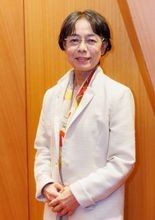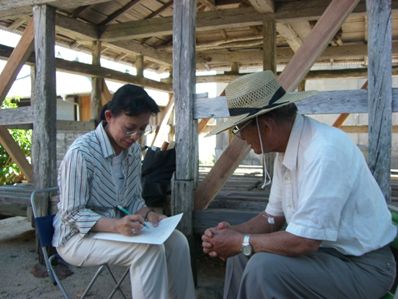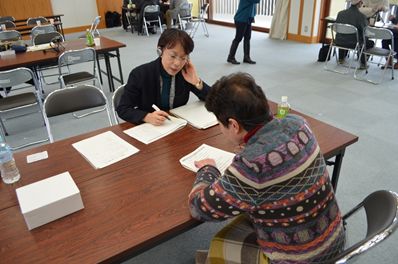Interview with KIBE Nobuko, the New President of the National Institutes for the Humanities

In April 2022, Dr. KIBE Nobuko took office as the new president of the National Institutes for the Humanities (NIHU). We asked her about herself, the future prospects for NIHU, the challenges it faces, and her aspirations as the new president.
Center for Innovative Research, National Institutes for the Humanities
1.Please tell us something about yourself that has not changed since you were a child, and about any interests you have outside your own direct area of research.
I’ve sung in a choir ever since my elementary school days. At the elementary school I attended, there was a teacher who was quite enthusiastic about choir instruction, and at whose invitation I took part in the NHK All-Japan School Choir Competition. That was what first got me hooked on choral singing. I joined choir clubs all through junior high school, high school, and university, and joined an adult choir when I began working. Once, in a Kagoshima choir, I took part in a choral contest sponsored by the Japan Choral Association and won a prize at the national competition. I’m particularly fond of Italian madrigals from the sixteenth and seventeenth centuries. I would like to join a choir in Tokyo, but I’m not as strong as I used to be and cannot project my voice as well as I would like. I wouldn’t want to be a nuisance to the other members of a choir, so at the moment I’m taking a break from singing.

2.Please tell us about something that has made a lasting impression on you from your own research.
I conduct surveys and research on regional dialects from all over Japan, especially those of Southern Kyushu and the Amami Islands. The survey I remember most vividly was one I conducted in the village of Toshima, which spans the Tokara Islands in Kagoshima Prefecture. The Tokara Archipelago consists of islands scattered between Yakushima and Amami-Oshima, and according to the 2015 census has a population of 756 people spread over its seven inhabited islands. I visited all seven of these islands from 1991 to 1994 to conduct a survey of dialects for my work on the Toshima Sonshi, a chronicle of the village’s history and folklore. This survey taught me about a lot more than merely dialects. For example, after the end of World War II, Toshima remained under U.S. occupation until February 1952. Although I had studied a little about American governance in Amami and Okinawa, this was the first time I realized that the effects of the war had reached even small islands like the Tokara Archipelago in the form of the occupation. Also, on the island of Akusekijima, which is part of Toshima, I met an elderly woman with an excellent memory. This old woman, who had never gone to elementary school and could not read or write, clearly remembered the size of the decrease in the island’s population due to an epidemic of ekiri (children’s dysentery) in a certain year. In a world without literacy, memory itself is history, and this encounter with an elderly woman who embodied this idea prompted me to think again about the relationship between oral and written culture.

In Kakeromajima, Kagoshima
3.What impressions did you have of the National Institutes for the Humanities and the National Institute for Japanese Language and Linguistics from the outside?
We cannot talk about the field of dialect research without mentioning theNational Institute for Japanese Language and Linguistics (NINJAL). NINJAL was established in 1948, shortly after the end of World War II, and since its inception has been a driving force not only in the issue of linguistic standardization and kanji notation, but also in surveys of dialects throughout Japan and research based thereon. For my own part, I have carried out a lot of research using its publications, such as the six-volume Nihon gengo chizu [Linguistic Atlas of Japan] (1966-1974), which maps the dialects of 2,400 locations throughout Japan, and Nihon hōgen no kijutsu-teki kenkyū [A Descriptive Study of Japanese Dialects] (1959), which describes the characteristics of the dialects of various regions. So for me, it was a great honor to participate in NINJAL’s surveys and projects. At the time, I had no idea that I would end up working at NINJAL. In comparison, the National Institutes for the Humanities (NIHU) seems to have a lower profile, among both researchers and the general public. To tell the truth, before I was appointed to NINJAL, NIHU was barely on my radar at all. This may be due to the relatively short history of NIHU, which was only established in 2004, but something should be done about this.

In Shiramine-mura, Ishikawa
4.What prospects and challenges do you see for NIHU, and what are your aspirations as the new president?
I guess one important thing will be to raise NIHU’s profile for both researchers and the general public. To this end, I would like to manage the organization in such a way as to ensure solid collaboration among the six institutions that make up NIHU, so that they can work together to promote research and contribute to society. These six institutions have already amassed an impressive body of research and a vast amount of data that constitute its empirical basis. My hope is that by linking the bodies of research and datasets held by each institution, we will be able to create new directions for research.
